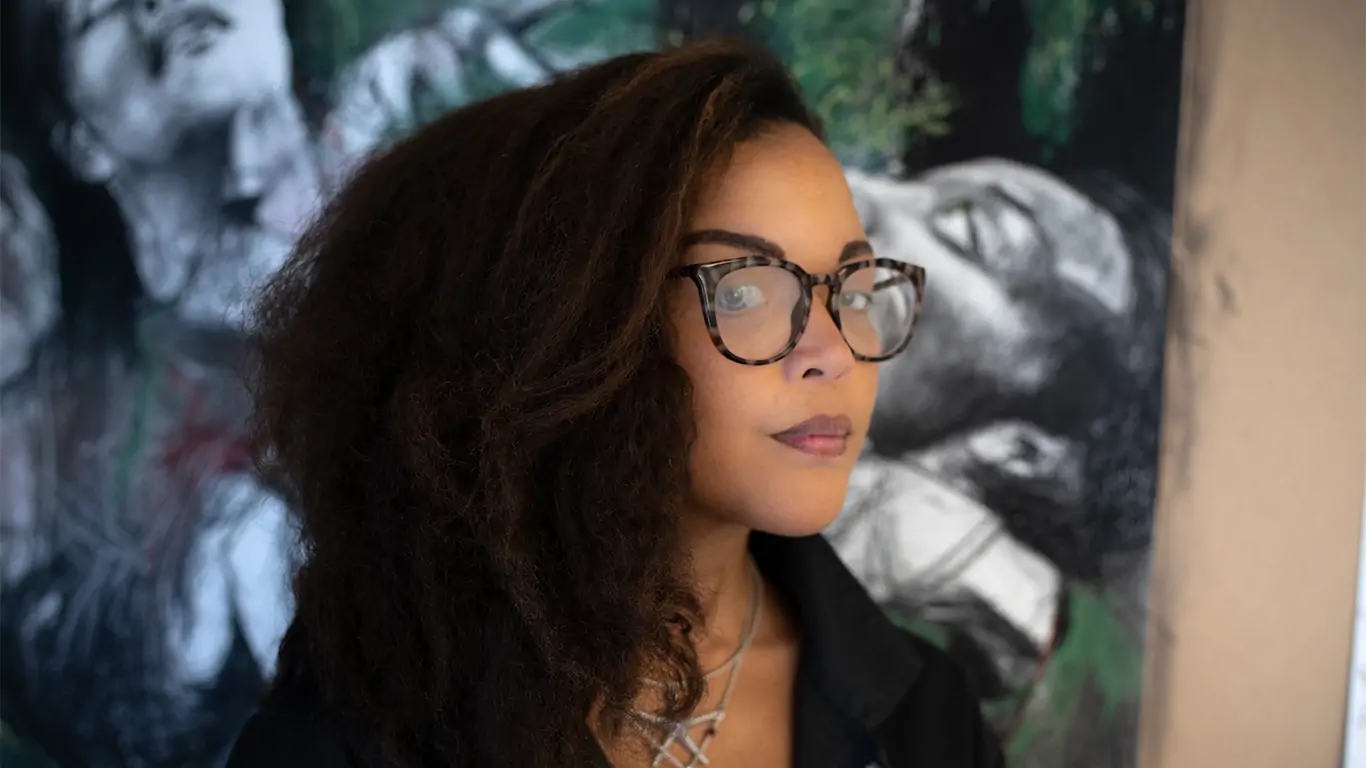Art takes many forms, and Phoebe Boswell‘s practice is a definitive example, as she sidesteps the clichés of artistic pigeonholing and categorisation through her lavish practice encompassing an eclectic range of mediums. Her work includes thought-provoking paintings, the acoustic and literary nuances of her video and written works, and immersive installations that often invite active participation, turning the structures into a symphony of space, experience, and reflection.
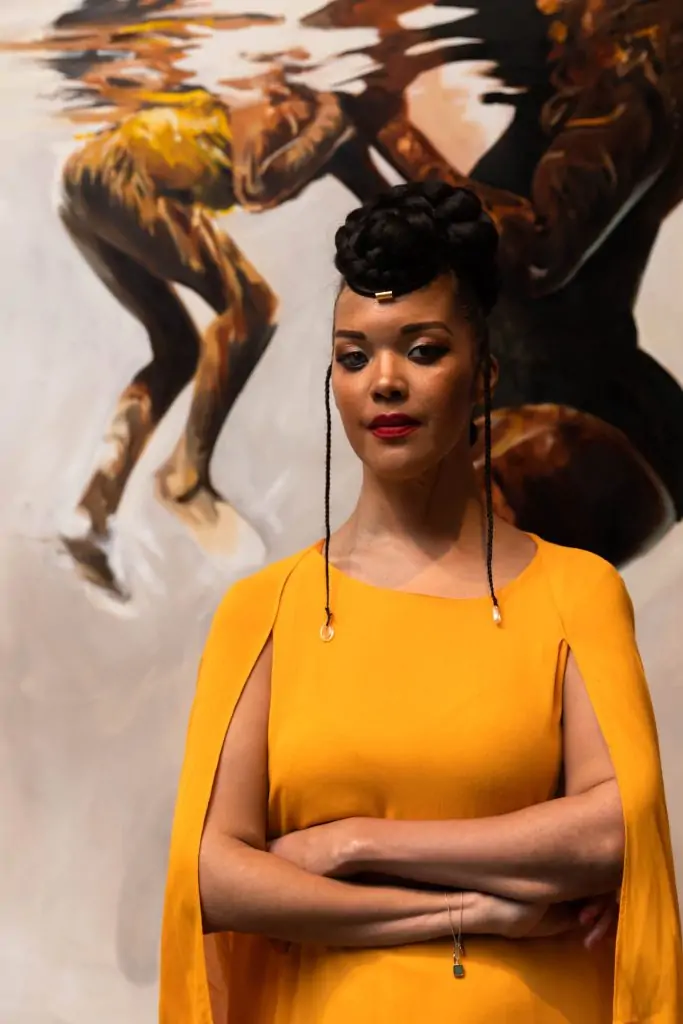
Photo by Briony Campbell
Image of courtesy of the artist
© Phoebe Boswell
We are in a moment – globally, politically, ecologically, as well as somatically, in our own bodies – that calls for a deep surrender, to all known language, to everything we think we know, so this has been liberating.
Phoebe Boswell
Throughout her work, Boswell delves into the past, the future, freedom, and critical social dilemmas. She views these themes through a diasporic lens, enriching her work with layers of displacement, cultural fusion, and identity negotiation. This provides a multifaceted perspective layered by experiences that characterise the diasporic condition. At the heart of Boswell’s approach is a sophisticated convergence of media underpinned by her lifelong practice of drawing. As a child, Boswell used drawing to explore ideas and understand her relationship with the world. This mode of ideation remains integral to her work.
Boswell’s storytelling is distinctive in its incorporation of multiple media and perspectives. She doesn’t just create art; she fosters a collective voice. This is evident in works like ‘A Tree Says [In These Boughs The World Rustles].’ Inspired by Hermann Hesse’s ‘Trees are Sanctuaries,’ Boswell collected questions through an open call, leading to interviews with a diverse group of nominated elders.
This project exemplifies Boswell’s layered storytelling and nurturing of active participation. In this work, Boswell turns trees into repositories of enquiry and wisdom. The experience encompasses soundscapes, interactive sculptures, intimate pencil studies, site-responsive wall drawings, and looped videos. All these elements work harmoniously to create an immersive environment. This installation invites the audience to connect within the gallery space and outside in the natural world.
Boswell has been nominated for and won numerous awards and has exhibited her works in various countries, including the UK, the US, South Africa, Sweden, Switzerland, Ukraine, and Italy. Receiving The Royal Photographic Society’s Lumière Award ‘for major achievement in cinematography, video or animation’ (2021) and the Paul Hamlyn Award for Artists (2019). Notably, she was the first Sky Academy Arts Scholarship recipient in 2011 and won the $20,000 Special Prize in the Future Generation Prize in 2017.
Boswell’s work is currently featured in the upcoming group exhibition ‘Constellations, Part 1: Figures on Earth & Beyond‘ at Gallery 1957 in London. This exhibition celebrates the burgeoning creative communities in Ghana and the UK.
We managed to catch up with Boswell during her participation in the exhibition to learn more about her practice, inspiration, and more.
Hi Phoebe, could you share your journey into the arts and what motivated you to pursue a career in the arts?
Phoebe Boswell: I have always drawn, I can’t really remember a beginning to my relationship with drawing. I was quite a pensive child I think, engrossed in the stories that swam around my interior, and drawing was a way of observing, both my thoughts and the outside, the world and the people around me. Through drawing I could observe, participate, question. I’ve always been curious about my place in relation I think. Our interconnectedness.
So pursuing art was a natural course, I didn’t question it, it was not a laboured decision, and I’m grateful for that. I was born in Kenya and grew up in the Arabian Gulf, and moved to England where I went to Central St Martins and the Slade. I loved figuration and wanted to be a painter. Honestly I didn’t particularly love – or “find myself” at – art school but I think perhaps this is common. The journey is long, life-long, never-ending in fact. As soon as I begin to think I’ve ‘found myself’, I subconsciously on purpose disrupt that thought. To be able to grapple with what this finding might be in the studio daily and call it a ‘career’ is one of life’s most penetrating gifts.
Your practice spans a diverse range of media, including drawing, painting, film, and sound. How do you decide which medium best suits the theme or topic of a particular piece?
Phoebe Boswell: I try to remain open to language, what language something requires, and how layered it needs to be. Over time, I have built up a sort of toolbox of media and methodology through which to speak, and I try to keep this growing and malleable. At the heart is always drawing, but I live for the nuance and the multilayeredness of us, our stories, our histories and our futures, and this demands an openness of method. So it’s very instinctive, intuitive; what usually happens is I will fixate on a theme, something that gnaws at my belly, and I will allow this to take me where it needs, until I know instinctively what form it demands.
Recently though, I’ve been lingering more intently on form, on what the material itself tells me – surrendering myself to the phenomenon of marks made by charcoal on paper, or oil paint on canvas, and allowing myself to go where they lead, rather than focusing so much on the dictates of theme or topic. I think we are in a moment – globally, politically, ecologically, as well as somatically, in our own bodies – that calls for a deep surrender, to all known language, to everything we think we know, so this has been liberating.
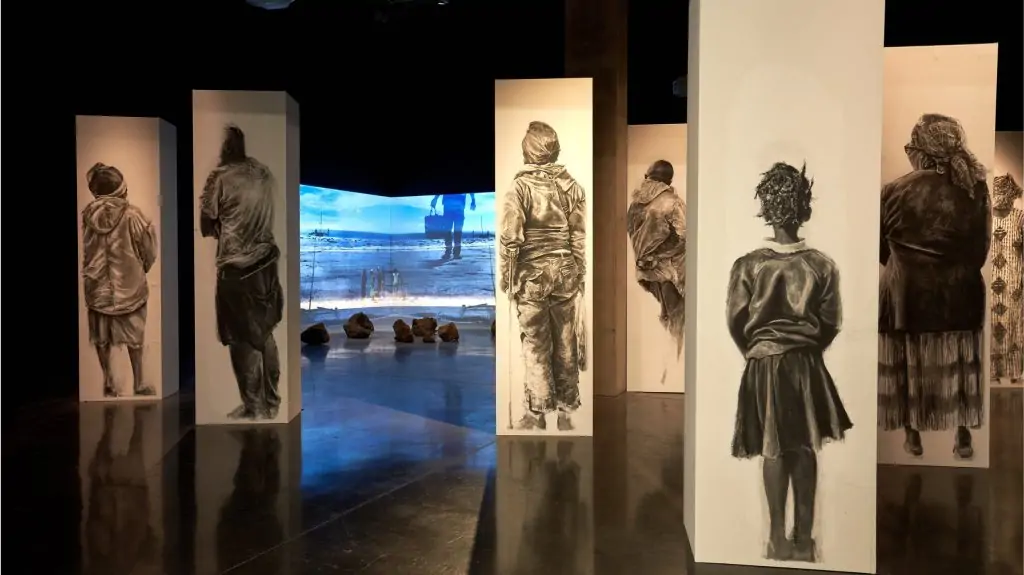
Image of courtesy of the artist
© Phoebe Boswell
Building on this, can you elaborate on how your diasporic perspective influences the themes and techniques in your work, especially when exploring themes like migration and identity?
Phoebe Boswell: My own history is one of layered contradictions and my life experience one of transient middle points so I come towards most things without desire for authority or a fixed or rigid position. I believe in fluid formations of knowledge forming, and in rhizomatic webs rather than hierarchical structures of knowledge. I believe that the whole is always greater than the sum of the parts. So my perspective plus your perspective plus her and his and their perspective is always going to get us somewhere way further than if I just claim to know where we are heading.
I’m not sure I’m answering your question but what I try to do is explore all things with this in mind. I mean, what does ‘identity’ become if we insist it stays fixed rather than open, transformative, ungovernable. That’s not to say we should not strive to know who we are, or how we have got here, it just encourages a restless, trembling sense of who we can be, both individually and collectively, if we don’t commit ourselves to the confines of a world that relies on unjust structures of knowledge and governance.
In your recent work, you explore the dichotomy of water as a symbol of both historical trauma and renewal. Could you discuss your approach to handling these complex yet emotionally charged themes?
Phoebe Boswell: I constantly find myself returning to the water as site. It holds within it the traumatic memory of historic and contemporary diasporic upheavals and migrations; it holds within it the hopeful geographical space between here and there, between notions of citizenship where perhaps we can begin to imagine freedom; it holds within it the capacity for healing and rebirth; and yet it is also vast, unknowable, and reminds us of our own insignificance.
For me, it becomes a place to consider all things, and I do this through writing, through process, through projects where I invite people to attempt to reclaim it, to feel safer in it. I’m always thinking about what is beyond the horizon of the body of water, that place just beyond our imagination, and how we’re going to get there. It’s an endless space of possibility, water, and I find myself returning to it again and again.
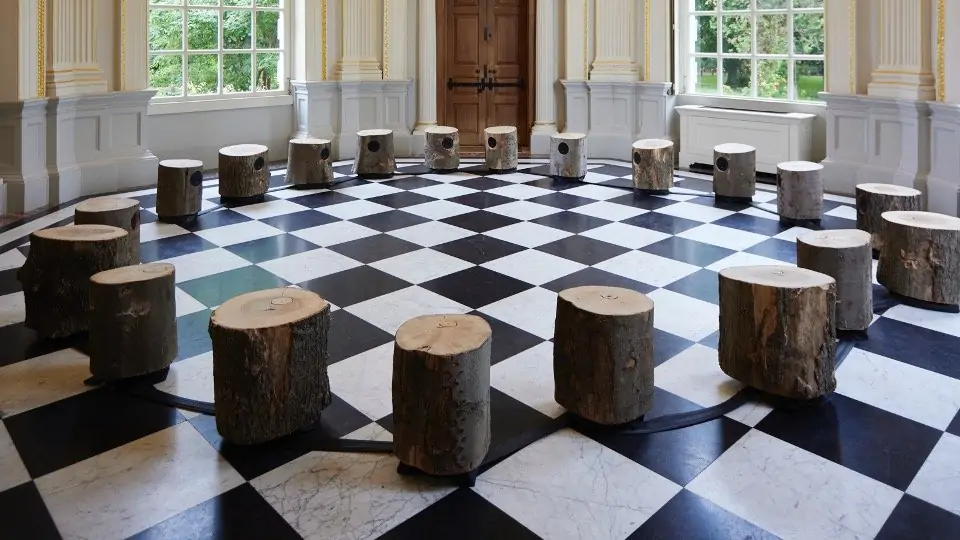
Image courtesy of the artist and Orleans House Gallery
© Phoebe Boswell
I’m intrigued by your interactive installations that actively involve audience participation, making them part of the creative process. How do you perceive the audience’s role in both the creation and interpretation of your art?
Phoebe Boswell: Oftentimes I see myself as a conduit for a gathering to take place, rather than the author of a work. I often wonder, as an artist, what it means to make something that someone else will encounter with their whole life within them, what it means to meet that person there, through the work, and how to be of service to that moment of meeting. I sometimes make large works where I call upon others to join me; I put out calls to arms, in a sense, for people to come and bring something of themselves to the work.
This could be answering a question, or engaging in breath work, or sending a self-authored photograph for me to draw from, or going on a journey with me about what it means to protest, what it feels like and looks like in the body. I’m always stunned by the generosity that these calls bring, and how rich the sum of each person’s contributions is to the whole, and my role then is to find a shape for the richness that has been gathered. And because it is already this multilayered thing in the process of its making, it becomes a multilayered thing in its outcome, and so it can then reach an audience in a multilayered way, as an open work, immersive, nothing fixed, multiple entry points. You meet it where you are, and that’s all I can hope for. And for me, when I witness that, it’s always a beautiful, rewarding thing.
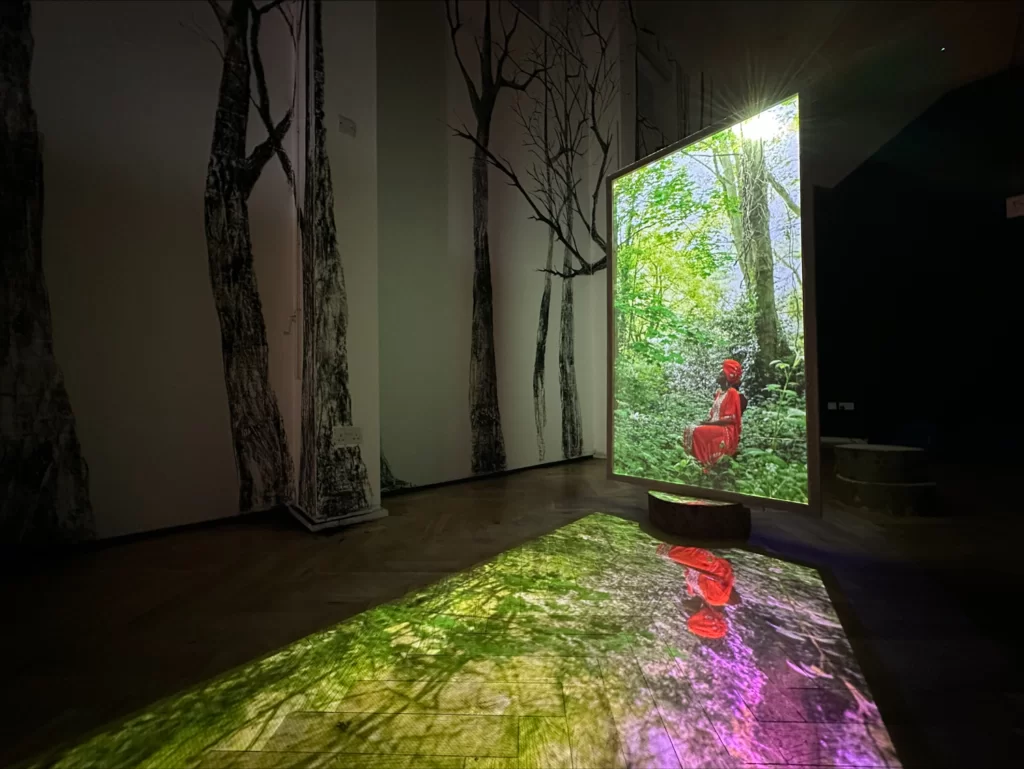
Image courtesy of the artist and Orleans House Gallery
© Phoebe Boswell
How does your interest in the ‘liminal space between our collective histories and imagined futures’ influence your work, and how do you visualize or represent these transitional, in-between states?
Phoebe Boswell: Perhaps I have answered this somehow, vaguely, in previous answers. It’s to do with layering, it’s to do with non-fixity, it’s to do with multiphonic perspectives, it’s to do with trying to keep work open, so you meet it where you are. It is temporal, it’s about acknowledging and making space for the past in order to imagine the future. It’s about bringing what we know, and also knowing that we do not know. That we are yet to know.
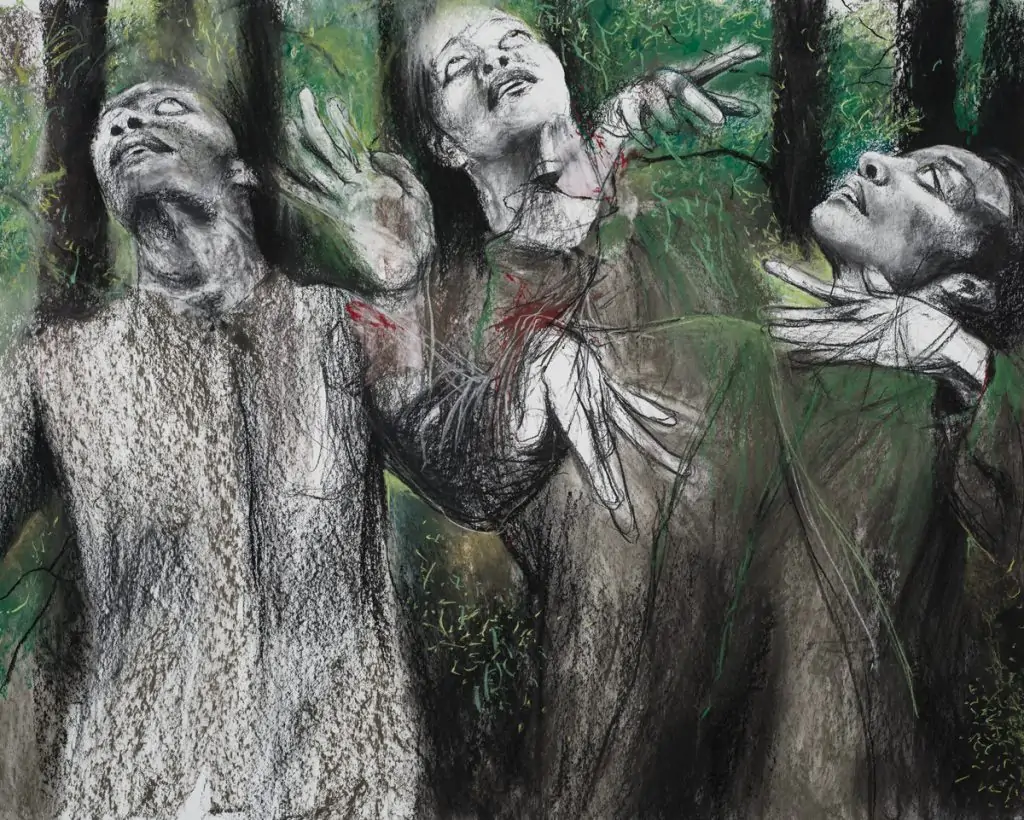
pastel on paper, 153cm x 123cm, courtesy the Artist and Gallery 1957
© Phoebe Boswell
Your work is featured in the upcoming group exhibition ‘Constellations, Part 1: Figures on Earth & Beyond’ at Gallery 1957 in London, which celebrates the burgeoning creative communities in Ghana and the UK. Could you tell us more about the essence of this exhibition and how your work fits into it?
Phoebe Boswell: Let me just pull up the curatorial notes real quick:
In line with ecofeminist scholar Donna Haraway’s Constellations –Part 1: Figures on Earth & Beyond rejects the idea of the Anthropocene Epoch, based on the idea that human activity is the dominant influence on the Earth’s climate and environment in the current geological age. The exhibition concept challenges our human inclination to centre ourselves and instead repositions humans as part of a larger ecosystem, critically examining human-made structures of power, memory, and agency within their wider environments through concepts of art history, spirituality, technology, and science fiction.
I’ve been thinking a lot about what we (can and must) learn from nature and the natural world, how our bodies, full of their own stories and hopes and neuroses, are all simply part of this wider ecosystem, and what that demands of us. I’m also thinking a lot about the natural world as site for a Black Feminist ecopoetics, where our bodies can find meaning and synergy in the ungovernability and wisdom of ecological terrain. Last year I had a solo show in the gallery and surrounding woodlands of Orleans House, titled A Tree Says (In These Boughs The World Rustles), in which I created an intergenerational call & response centring the voices of our elders, where trees became repositories of enquiry. The drawings in the show at Gallery 1957 extend from that work and their titles come from Hermann Hesse’s writing on trees, which became a catalyst for me.
Trees are sanctuaries. Whoever knows how to speak to them, whoever knows how to listen to them, can learn the truth. They do not preach learning and precepts, they preach, undeterred by particulars, the ancient law of life. – Hermann Hesse

Liminal Deity, pastel on paper, 2023 (L)
The Present Juncture of Entanglement, 2023 (R)
Solo exhibition installed at Wentrup Gallery, Berlin, 2023
Image courtesy of the artist and Wentrup Gallery
© Phoebe Boswell
In a world filled with distractions and external pressures, how do you navigate and sustain your creative rhythm, given the inherently unpredictable and recursive nature of artistic creation?
Phoebe Boswell: I think it’s important to allow some of the unpredictability of the world to rock and sway your practice, to be honest. We do not make work in a vacuum, it is always a delicate choreography between what is occurring in the world, our place within that occurrence, and the sanctuary of the studio. That said, it is also important to grant oneself the space and steadiness needed to fully immerse in the making, without the distraction of exterior voices, influence and noise.
So it is a balance. And not one I always get right, but I do know that, ultimately, that ‘creative rhythm’ doesn’t ever go away. Not truly. It will always be there to return to or redetermine. I trust that. What I’m thinking a lot about right now is how this world can break your heart. And how your work can heal it if you allow yourself to acknowledge its breaking. If you allow it to move you out of your steady beat, even momentarily, to see what it has to tell you. We navigate through the storms of things and we find ourselves necessarily elsewhere.
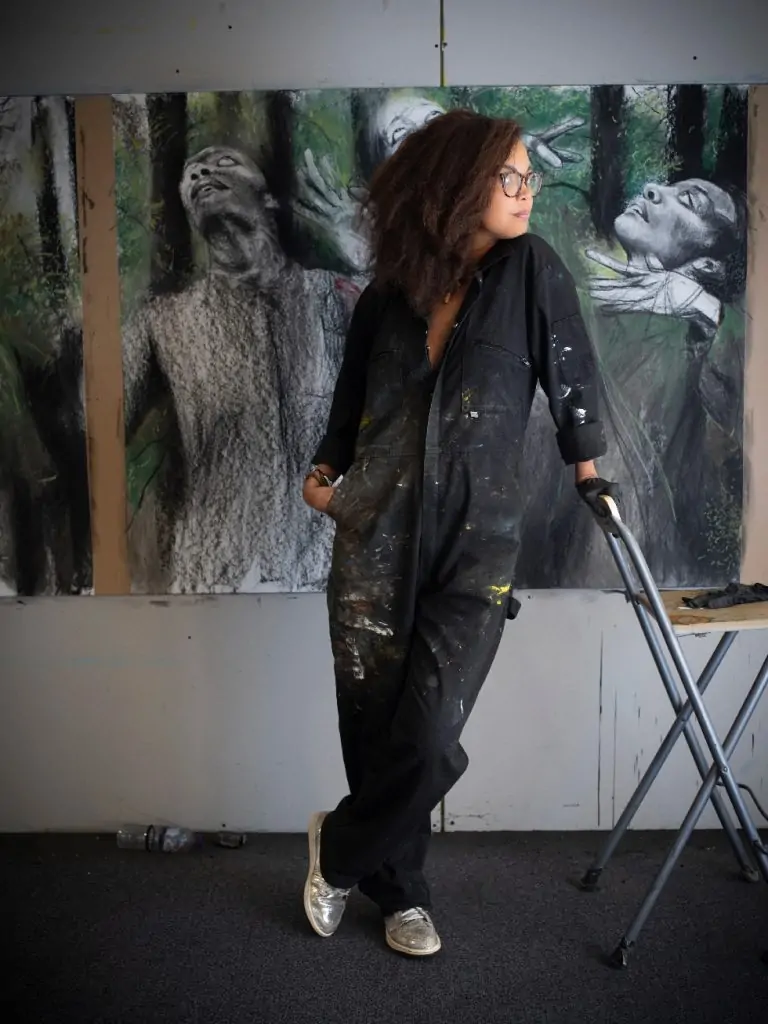
Image of courtesy of the artist
© Phoebe Boswell
Credit Ric Bower
Looking to the future, what innovative strategies or collaborations are you considering? Are there specific themes or creative techniques you are particularly excited to explore next?
Phoebe Boswell: I remain excited to experiment more with immersive space, sound, performance. I am also writing and this is opening up new worlds for me to bathe in. And I’m excited about these paintings I’m making in the studio, and this charcoal work, which is messy and clawing and may never be shown, but I think that’s exciting and important too, to make things not always with the intention of their exhibition but just because they need to come out, right here right now.
Lastly, could you share your philosophy of art? How do you define and interpret the essence and significance of art in your life and work?
Phoebe Boswell: It is a living, breathing thing.
https://www.instagram.com/phoebe.boswell/
©2024 Phoebe Boswell


